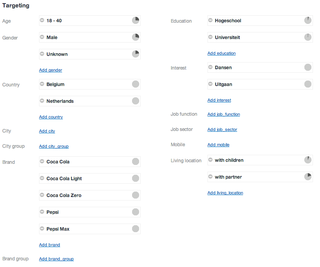
Privacy is the ability of an individual or group to seclude themselves or information about themselves, and thereby express themselves selectively.

In computer networking, a proxy server is a server application that acts as an intermediary between a client requesting a resource and the server providing that resource. It improves privacy, security, and performance in the process.

Surveillance is the monitoring of behavior, many activities, or information for the purpose of information gathering, influencing, managing or directing. This can include observation from a distance by means of electronic equipment, such as closed-circuit television (CCTV), or interception of electronically transmitted information like Internet traffic. It can also include simple technical methods, such as human intelligence gathering and postal interception.
Computer and network surveillance is the monitoring of computer activity and data stored locally on a computer or data being transferred over computer networks such as the Internet. This monitoring is often carried out covertly and may be completed by governments, corporations, criminal organizations, or individuals. It may or may not be legal and may or may not require authorization from a court or other independent government agencies. Computer and network surveillance programs are widespread today and almost all Internet traffic can be monitored.
Internet privacy involves the right or mandate of personal privacy concerning the storage, re-purposing, provision to third parties, and display of information pertaining to oneself via the Internet. Internet privacy is a subset of data privacy. Privacy concerns have been articulated from the beginnings of large-scale computer sharing and especially relate to mass surveillance.
Web analytics is the measurement, collection, analysis, and reporting of web data to understand and optimize web usage. Web analytics is not just a process for measuring web traffic but can be used as a tool for business and market research and assess and improve website effectiveness. Web analytics applications can also help companies measure the results of traditional print or broadcast advertising campaigns. It can be used to estimate how traffic to a website changes after launching a new advertising campaign. Web analytics provides information about the number of visitors to a website and the number of page views, or create user behavior profiles. It helps gauge traffic and popularity trends, which is useful for market research.

Google Analytics is a web analytics service offered by Google that tracks and reports website traffic and also the mobile app traffic & events, currently as a platform inside the Google Marketing Platform brand. Google launched the service in November 2005 after acquiring Urchin.
A click path or clickstream is the sequence of hyperlinks one or more website visitors follows on a given site, presented in the order viewed. A visitor's click path may start within the website or at a separate third party website, often a search engine results page, and it continues as a sequence of successive webpages visited by the user. Click paths take call data and can match it to ad sources, keywords, and/or referring domains, in order to capture data.

Digital footprint or digital shadow refers to one's unique set of traceable digital activities, actions, contributions, and communications manifested on the Internet or digital devices. Digital footprints can be classified as either passive or active. The former is composed of a user's web-browsing activity and information stored as cookies. The latter is often released deliberately by a user to share information on websites or social media. While the term usually applies to a person, a digital footprint can also refer to a business, organization or corporation.

Targeted advertising is a form of advertising, including online advertising, that is directed towards an audience with certain traits, based on the product or person the advertiser is promoting.
Employee monitoring is the surveillance of workers' activity. Organizations engage in employee monitoring for different reasons such as to track performance, to avoid legal liability, to protect trade secrets, and to address other security concerns. This practice may impact employee satisfaction due to its impact on the employee's privacy. Among organizations, the extent and methods of employee monitoring differ.
Web tracking is the practice by which operators of websites and third parties collect, store and share information about visitors’ activities on the World Wide Web. Analysis of a user's behaviour may be used to provide content that enables the operator to infer their preferences and may be of interest to various parties, such as advertisers. Web tracking can be part of visitor management.
Computer surveillance in the workplace is the use of computers to monitor activity in a workplace. Computer monitoring is a method of collecting performance data which employers obtain through digitalised employee monitoring. Computer surveillance may nowadays be used alongside traditional security applications, such as closed-circuit television.
Since the arrival of early social networking sites in the early 2000s, online social networking platforms have expanded exponentially, with the biggest names in social media in the mid-2010s being Facebook, Instagram, Twitter and Snapchat. The massive influx of personal information that has become available online and stored in the cloud has put user privacy at the forefront of discussion regarding the database's ability to safely store such personal information. The extent to which users and social media platform administrators can access user profiles has become a new topic of ethical consideration, and the legality, awareness, and boundaries of subsequent privacy violations are critical concerns in advance of the technological age.
Corporate surveillance describes the practice of businesses monitoring and extracting information from their users, clients, or staff. This information may consist of online browsing history, email correspondence, phone calls, location data, and other private details. Acts of corporate surveillance frequently look to boost results, detect potential security problems, or adjust advertising strategies. These practices have been criticized for violating ethical standards and invading personal privacy. Critics and privacy activists have called for businesses to incorporate rules and transparency surrounding their monitoring methods to ensure they are not misusing their position of authority or breaching regulatory standards.
Google's changes to its privacy policy on March 16, 2012, enabled the company to share data across a wide variety of services. These embedded services include millions of third-party websites that use AdSense and Analytics. The policy was widely criticized for creating an environment that discourages Internet innovation by making Internet users more fearful and wary of what they do online.
Cross-device tracking is technology that enables the tracking of users across multiple devices such as smartphones, television sets, smart TVs, and personal computers.
Data shadows refer to the information that a person leaves behind unintentionally while taking part in daily activities such as checking their e-mails, scrolling through social media or even by using their debit or credit card.
Search engine privacy is a subset of internet privacy that deals with user data being collected by search engines. Both types of privacy fall under the umbrella of information privacy. Privacy concerns regarding search engines can take many forms, such as the ability for search engines to log individual search queries, browsing history, IP addresses, and cookies of users, and conducting user profiling in general. The collection of personally identifiable information (PII) of users by search engines is referred to as tracking.
Spy pixels or tracker pixels are hyperlinks to remote image files in HTML email messages that have the effect of spying on the person reading the email if the image is downloaded. They are commonly embedded in the HTML of an email as small, imperceptible, transparent graphic files. Spy pixels are commonly used in marketing, and there are several countermeasures in place that aim to block email tracking pixels. However, there are few regulations in place that effectively guard against email tracking approaches.







